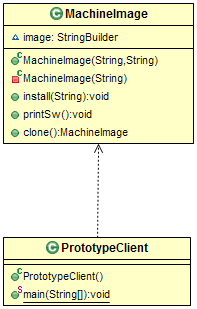Specify the kinds of objects to create using a prototypical instance, and create new objects by copying this prototype.
When to use
- To improve the performance when object creation is costly and time consuming.
- To simplify and optimize multiple objects creation that will have mostly the same data
Intent
Specify the kinds of objects to create using a prototypical instance, and create new objects by copying this prototype.
Components
A class that implements Cloneable interface (public)
Structure
Implementation
Most of the cloud platforms behave like Prototype pattern to create instances quickly upon requests. This is achieved with the help of pre-installed Machine Images. When a customer wants a Windows or Linux instance, the cloud software just loads the already created machine image on to a server hardware (rather than going through the complete installation process). This saves a lot of time.
1 Create a base machine image by installing the specified OS and antivirus software. Provide a 'clone' method so that client can create an object without using a time consuming 'new' operator every time.
package com.gaurav.prototype;
public class MachineImage implements Cloneable {
StringBuilder image;
public MachineImage(String os, String antivirusSW) {
image = new StringBuilder();
image.append(os)
.append(" + " + antivirusSW);
}
private MachineImage(String sw) {
image = new StringBuilder(sw);
}
public void install(String sw) {
image.append(sw);
}
public void printSw() {
System.out.println(image);
}
@Override
public MachineImage clone()
throws CloneNotSupportedException {
return new MachineImage(this.image.toString());
}
}
2 The client code. The client creates a base image and clones it to create other images.
package com.gaurav.client;
import com.gaurav.prototype.MachineImage;
public class PrototypeClient {
public static void main(String [] args)
throws CloneNotSupportedException {
/* Create base Machine Images */
MachineImage linuxVM= new MachineImage("Linux", "Symantec");
MachineImage windowsVM = new MachineImage("Windows", "MaAfee");
/* Clone Linux VM and Install Web Server */
MachineImage webServer= linuxVM.clone();
webServer.install(" + Web Server S/W");
/* Create a copy of the Web Server and
* install Application server on top of it */
MachineImage webAppServer = webServer.clone();
webAppServer.install(" + App Server S/W");
/* Clone Linux VM and Install DB Server */
MachineImage dbServer= linuxVM.clone();
dbServer.install(" + Database Server S/W");
/* Create a test machine from Windows Image */
MachineImage testMachine= windowsVM.clone();
System.out.print("Web Server Configuration: ");
webServer.printSw();
System.out.print("App Server Configuration: ");
webAppServer.printSw();
System.out.print("DB Server Configuration: ");
dbServer.printSw();
System.out.print("Test Machine Configuration: ");
testMachine.printSw();
}
}
Output
[output]
Web Server Configuration: Linux OS + Antivirus S/W + Web Server S/W
App Server Configuration: Linux OS + Antivirus S/W + Web Server S/W + App Server S/W
DB Server Configuration: Linux OS + Antivirus S/W + Database Server S/W
Test Machine Configuration: Linux OS + Antivirus S/W
Benefits
- Performance: Cloning (using MemberwiseClone) is considerably less expensive than creating a new object afresh (with new operator).
- Objects can be cloned very dynamically, without any insistence on up-front instantiation. The first created object can be created at any time in the application execution, and further duplication can take place at any time ahead.
Drawbacks
- Deep copy has to be handled carefully.
Real World Examples
- Biological Cell splitting
Software Examples
- Virtual Machine Images - Have one image per OS which has all the required s/w installed.
- DVD duplication - Duplication of the master dvd to create several copies.
Java SDK Examples
java.lang.Object clone()
Hope you like it. Would love to hear your thoughts on this design pattern.
Want to discuss more
Lets have a Coffee



Top comments (0)